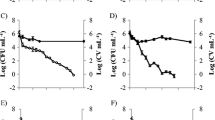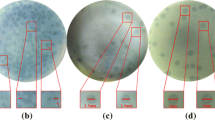Abstract
Piscirickettsia salmonis is a facultative Gram-negative intracellular bacterium that produces piscirickettsiosis, disease that causes a high negative impact in salmonid cultures. The so-far-unidentified nutritional requirements have hindered its axenic culture at laboratory and industrial scales for the formulation of vaccines. The present study describes the development of a defined culture medium for P. salmonis. The culture medium was formulated through rational design involving auxotrophy test and statistical designs of experiments, considering the genome-scale metabolic reconstruction of P. salmonis reported by our group. The whole optimization process allowed for a twofold increase in biomass and a reduction of about 50% of the amino acids added to the culture medium. The final culture medium contains twelve amino acids, where glutamic acid, threonine and arginine were the main carbon and energy sources, supporting 1.65 g/L of biomass using 6.5 g/L of amino acids in the formulation. These results will contribute significantly to the development of new operational strategies to culture this bacterium for the production of vaccines.





Similar content being viewed by others
References
Albornoz R, Valenzuela K, Pontigo JP et al (2017) Identification of chemotaxis operon cheYZA and cheA gene expression under stressful conditions in Piscirickettsia salmonis. Microb Pathog 107:436–441
Arkush KD, McBride AM, Mendonca HL et al (2005) Genetic characterization and experimental pathogenesis of Piscirickettsia salmonis isolated from white seabass Atractoscion nobilis. Dis Aquat Organ 63:139–149
Athanassopoulou F, Groman D, Prapas T, Sabatakou O (2004) Pathological and epidemiological observations on rickettsiosis in cultured sea bass (Dicentrarchus labrax L.) from Greece. J Appl Ichthyol 20:525–529
Bartolucci AA, Singh KP, Bae S (2015) Robustness and Ruggedness. In: Bartolucci AA, Singh KP, Bae S (eds) Introduction to statistical analysis of laboratory data. Wiley, New York, pp 213–234
Bhatnagar RK, Berry A, Hendry AT, Jensen RA (1989) The biochemical basis for growth inhibition by l-phenylalanine in Neisseria gonorrhoeae. Mol Microbiol 3:429–435
Birkbeck TH, Griffen AA, Reid HI et al (2004) Growth of Piscirickettsia salmonis to high titers in insect tissue culture cells. Infect Immun 72:3693–3694. https://doi.org/10.1128/IAI.72.6.3693
Braun PR, Al-Younes H, Gussmann J et al (2008) Competitive inhibition of amino acid uptake suppresses chlamydial growth: involvement of the chlamydial amino acid transporter BrnQ. J Bacteriol 190:1822–1830
Bravo S, Campos M (1989) Coho salmon syndrome in Chile. FHS/AFS Newsl 17:3
Christgen SL, Becker DF (2019) Role of proline in pathogen and host interactions. Antioxid Redox Signal 30:683–709. https://doi.org/10.1089/ars.2017.7335
Contreras-Lynch S, Olmos P, Vargas A et al (2015) Identification and genetic characterization of Piscirickettsia salmonis in native fish from southern Chile. Dis Aquat Organ 115:233–244
Cortés MP, Mendoza SN, Travisany D et al (2017) Analysis of Piscirickettsia salmonis metabolism using genome-scale reconstruction, modeling, and testing. Front Microbiol 8:2462
Das M, Grover A (2018) Fermentation optimization and mathematical modeling of glycerol-based microbial poly(3-hydroxybutyrate) production. Process Biochem 71:1–11. https://doi.org/10.1016/j.procbio.2018.05.017
De Felice M, Levinthal M, Iaccarino M, Guardiola J (1979) Growth inhibition as a consequence of antagonism between related amino acids: effect of valine in Escherichia coli K-12. Microbiol Rev 43:42
Eliassen TM, Solbakk IT, Haugseth KT et al (2007) Process for culturing bacteria of the Piscirickettsia genus. Patent Application WO 2008/002152 A8. https://www.lens.org/lens/patent/WO_2008_002152_A8_20090723
Englesberg E, Bass R, Heiser W (1976) Inhibition of the growth of mammalian cells in culture by amino acids and the isolation and characterization of l-phenylalanine-resistant mutants modifying l-phenylalanine transport. Somat Cell Genet 2:411–428
Ferber DM, Ely B (1982) Resistance to amino acid inhibition in Caulobacter crescentus. Mol Gen Genet MGG 187:446–452
Fryer JL, Lannan CN, Garcés LH et al (1990) Isolation of a rickettsiales-like organism from diseased coho salmon (Oncorhynchus kisutch) in Chile. Fish Pathol 25:107–114
Fryer JL, Lannan CN, Giovannoni SJ, Wood ND (1992) Piscirickettsia salmonis gen. nov., sp. nov., the causative agent of an epizootic disease in salmonid fishes. Int J Syst Evol Microbiol 42:120–126
Fu XT, Lin H, Kim SM (2009) Optimization of medium composition and culture conditions for agarase production by Agarivorans albus YKW-34. Process Biochem 44:1158–1163. https://doi.org/10.1016/j.procbio.2009.06.012
Fuentealba P, Aros C, Latorre Y et al (2017) Genome-scale metabolic reconstruction for the insidious bacterium in aquaculture Piscirickettsia salmonis. Bioresour Technol 223:105–114
Gesbert G, Ramond E, Tros F et al (2015) Importance of branched-chain amino acid utilization in Francisella intracellular adaptation. Infect Immun 83:173–183
Gómez F, Henríquez V, Marshall S (2009) Additional evidence of the facultative intracellular nature of the fish bacterial pathogen Piscirickettsia salmonis. Arch Med Vet 41:261–267
Henríquez M, González E, Marshall SH et al (2013) A novel liquid medium for the efficient growth of the salmonid pathogen Piscirickettsia salmonis and optimization of culture conditions. PLoS One 8:e71830. https://doi.org/10.1371/journal.pone.0071830
Hobley L, Harkins C, MacPhee CE, Stanley-Wall NR (2015) Giving structure to the biofilm matrix: an overview of individual strategies and emerging common themes. FEMS Microbiol Rev 39:649–669
Jain SP, Singh PP, Javeer S, Amin PD (2010) Use of Placket–Burman statistical design to study effect of formulation variables on the release of drug from hot melt sustained release extrudates. AAPS PharmSciTech 11:936–944. https://doi.org/10.1208/s12249-010-9444-6
Janakiraman A, Lesser CF (2017) How to manage stress: lessons from an intracellular pathogen. Virulence 8:359–361. https://doi.org/10.1080/21505594.2016.1256538
Johnson CL, Vishniac W (1970) Growth inhibition in Thiobacillus neapolitanus by histidine, methionine, phenylalanine, and threonine. J Bacteriol 104:1145–1150
Jolivet-Gougeon A, Bonnaure-Mallet M (2014) Biofilms as a mechanism of bacterial resistance. Drug Discov Today Technol 11:49–56
Koch AL (2007) Growth Measurement. In: Reddy CA, Beveridge TJ, Breznak JA et al (eds) Methods for general and molecular microbiology, 3rd edn. ASM Press, Washington D.C., pp 172–199
Lawson J, Erjavec J (2017) Screening designs. In: Lawson J, Erjavec J (eds) Basic experimental strategies and data analysis for science and engineering. CRC Press, Boca Raton, pp 163–201
Link H, Weuster-Botz D (2011) 2.11—medium formulation and development. In: Moo-Young M (ed) Comprehensive biotechnology, 2nd edn. Academic, Burlington, pp 119–134
Maisey K, Montero R, Christodoulides M (2017) Vaccines for piscirickettsiosis (salmonid rickettsial septicaemia, SRS): the Chile perspective. Expert Rev Vaccines 16:215–228. https://doi.org/10.1080/14760584.2017.1244483
Manske C, Hilbi H (2014) Metabolism of the vacuolar pathogen Legionella and implications for virulence. Front Cell Infect Microbiol 4:125
Marshall SH, Gómez FA, Ramírez R et al (2012) Biofilm generation by Piscirickettsia salmonis under growth stress conditions: a putative in vivo survival/persistence strategy in marine environments. Res Microbiol 163:557–566
Mauel MJ, Ware C, Smith P (2008) Culture of Piscirickettsia salmonis on enriched blood agar. J Vet Diagn Investig 20:213–214. https://doi.org/10.1177/104063870802000211
Meibom KL, Charbit A (2010) Francisella tularensis metabolism and its relation to virulence. Front Microbiol. https://doi.org/10.3389/fmicb.2010.00140
Mikalsen J, Skjaervik O, Wiik-Nielsen J et al (2008) Agar culture of Piscirickettsia salmonis, a serious pathogen of farmed salmonid and marine fish. FEMS Microbiol Lett 278:43–47. https://doi.org/10.1111/j.1574-6968.2007.00977.x
Monds RD, O’Toole GA (2009) The developmental model of microbial biofilms: ten years of a paradigm up for review. Trends Microbiol 17:73–87. https://doi.org/10.1016/j.tim.2008.11.001
Nagata Y, Chu KH (2003) Optimization of a fermentation medium using neural networks and genetic algorithms. Biotechnol Lett 25:1837–1842. https://doi.org/10.1023/a:1026225526558
Navarrete-Bolaños JL, Téllez-Martínez MG, Miranda-López R, Jiménez-Islas H (2017) An experimental strategy validated to design cost-effective culture media based on response surface methodology. Prep Biochem Biotechnol 47:578–588. https://doi.org/10.1080/10826068.2017.1280825
Omsland A, Sixt BS, Horn M, Hackstadt T (2014) Chlamydial metabolism revisited: interspecies metabolic variability and developmental stage-specific physiologic activities. FEMS Microbiol Rev 38:779–801
Patil S, Nikam M, Patil H et al (2017) Bioactive pigment production by Pseudomonas spp. MCC 3145: statistical media optimization, biochemical characterization, fungicidal and DNA intercalation-based cytostatic activity. Process Biochem 58:298–305. https://doi.org/10.1016/j.procbio.2017.05.003
Pitol LO, Finkler ATJ, Dias GS et al (2017) Optimization studies to develop a low-cost medium for production of the lipases of Rhizopus microsporus by solid-state fermentation and scale-up of the process to a pilot packed-bed bioreactor. Process Biochem 62:37–47. https://doi.org/10.1016/j.procbio.2017.07.019
Plackett RL, Burman JP (1946) The design of optimum multifactorial experiments. Biometrika 33:305–325
Price CTD, Richards AM, Abu Kwaik Y (2014) Nutrient generation and retrieval from the host cell cytosol by intra-vacuolar Legionella pneumophila. Front Cell Infect Microbiol 4:111
Rinaudi LV, Giordano W (2010) An integrated view of biofilm formation in rhizobia. FEMS Microbiol Lett 304:1–11
Rozas M, Enríquez R (2014) Piscirickettsiosis and Piscirickettsia salmonis in fish: a review. J Fish Dis 37:163–188. https://doi.org/10.1111/jfd.12211
Sargent B (2011) The need for defined, animal-free, components in vaccine production media. http://cellculturedish.com/the-need-for-defined-animal-free-components-in-vaccine-production-media/
Sernapesca (2018) Informe Sanitario de Salmonicultura en Centros Marinos—Año 2017. http://www.sernapesca.cl/sites/default/files/informe_sanitario_2017_0.pdf
Seth AK, Geringer MR, Hong SJ et al (2012) In vivo modeling of biofilm-infected wounds: a review. J Surg Res 178:330–338
Spaargaren DH (1996) The design of culture media based on the elemental composition of biological material. J Biotechnol 45:97–102. https://doi.org/10.1016/0168-1656(95)00152-2
Stellwagen E, Prantner JD, Stellwagen NC (2008) Do zwitterions contribute to the ionic strength of a solution? Anal Biochem 373:407–409. https://doi.org/10.1016/j.ab.2007.10.038
Tandberg JI, Lagos LX, Langlete P et al (2016) Comparative analysis of membrane vesicles from three Piscirickettsia salmonis isolates reveals differences in vesicle characteristics. PLoS One 11:e0165099. https://doi.org/10.1371/journal.pone.0165099
Yañez AJ, Valenzuela K, Silva H et al (2012) Broth medium for the successful culture of the fish pathogen Piscirickettsia salmonis. Dis Aquat Organ 97:197–205. https://doi.org/10.3354/dao02403
Yañez AJ, Silva H, Valenzuela K et al (2013) Two novel blood-free solid media for the culture of the salmonid pathogen Piscirickettsia salmonis. J Fish Dis 36:587–591
Zhang J, Greasham R (1999) Chemically defined media for commercial fermentations. Appl Microbiol Biotechnol 51:407–421. https://doi.org/10.1007/s002530051411
Zuo S, Xiao J, Zhang Y et al (2018) Rational design and medium optimization for shikimate production in recombinant Bacillus licheniformis strains. Process Biochem 66:19–27. https://doi.org/10.1016/j.procbio.2017.12.012
Acknowledgements
This work was supported by the FONDEF project [Grant Number D10I1185] and PhD scholarship CONICYT of Ministry of Education, Chile government.
Author information
Authors and Affiliations
Corresponding author
Ethics declarations
Obtained data supported the patent application WO2016082050A1.
Additional information
Publisher's Note
Springer Nature remains neutral with regard to jurisdictional claims in published maps and institutional affiliations.
Electronic supplementary material
Below is the link to the electronic supplementary material.
Rights and permissions
About this article
Cite this article
Fuentealba, P., Latorre, Y., González, E. et al. Engineering a defined culture medium to grow Piscirickettsia salmonis for its use in vaccine formulations. J Ind Microbiol Biotechnol 47, 299–309 (2020). https://doi.org/10.1007/s10295-020-02265-9
Received:
Accepted:
Published:
Issue Date:
DOI: https://doi.org/10.1007/s10295-020-02265-9




